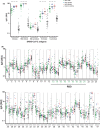Neutralization of SARS-CoV-2 requires antibodies against conformational receptor-binding domain epitopes
- PMID: 34453317
- PMCID: PMC8653362
- DOI: 10.1111/all.15066
Neutralization of SARS-CoV-2 requires antibodies against conformational receptor-binding domain epitopes
Abstract
Background: The determinants of successful humoral immune response to the severe acute respiratory syndrome coronavirus 2 (SARS-CoV-2) are of critical importance for the design of effective vaccines and the evaluation of the degree of protective immunity conferred by exposure to the virus. As novel variants emerge, understanding their likelihood of suppression by population antibody repertoires has become increasingly important.
Methods: In this study, we analyzed the SARS-CoV-2 polyclonal antibody response in a large population of clinically well-characterized patients after mild and severe COVID-19 using a panel of microarrayed structurally folded and unfolded SARS-CoV-2 proteins, as well as sequential peptides, spanning the surface spike protein (S) and the receptor-binding domain (RBD) of the virus.
Results: S- and RBD-specific antibody responses were dominated by immunoglobulin G (IgG), mainly IgG1 , and directed against structurally folded S and RBD and three distinct peptide epitopes in S2. The virus neutralization activity of patients´ sera was highly correlated with IgG antibodies specific for conformational but not sequential RBD epitopes and their ability to prevent RBD binding to its human receptor angiotensin-converting enzyme 2 (ACE2). Twenty percent of patients selectively lacked RBD-specific IgG. Only immunization with folded, but not with unfolded RBD, induced antibodies against conformational epitopes with high virus-neutralizing activity. Conformational RBD epitopes required for protection do not seem to be altered in the currently emerging virus variants.
Conclusion: These results are fundamental for estimating the protective activity of antibody responses after natural infection or vaccination and for the design of vaccines, which can induce high levels of SARS-CoV-2-neutralizing antibodies conferring sterilizing immunity.
Keywords: COVID-19; SARS-CoV-2; conformational epitopes; vaccine; virus neutralization.
© 2021 The Authors. Allergy published by European Academy of Allergy and Clinical Immunology and John Wiley & Sons Ltd.
Conflict of interest statement
Rudolf Valenta has received research grants from HVD Life‐Sciences, Vienna, Austria, WORG Pharmaceuticals, Hangzhou, China and from Viravaxx AG, Vienna, Austria. He serves as consultant for Viravaxx AG. Renata Kiss, Frank Stolz and Rainer Henning are employees of Viravaxx AG, Vienna, Austria. The other authors have no conflict of interest to declare.
Figures




References
Publication types
MeSH terms
Substances
Grants and funding
LinkOut - more resources
Full Text Sources
Other Literature Sources
Medical
Research Materials
Miscellaneous

